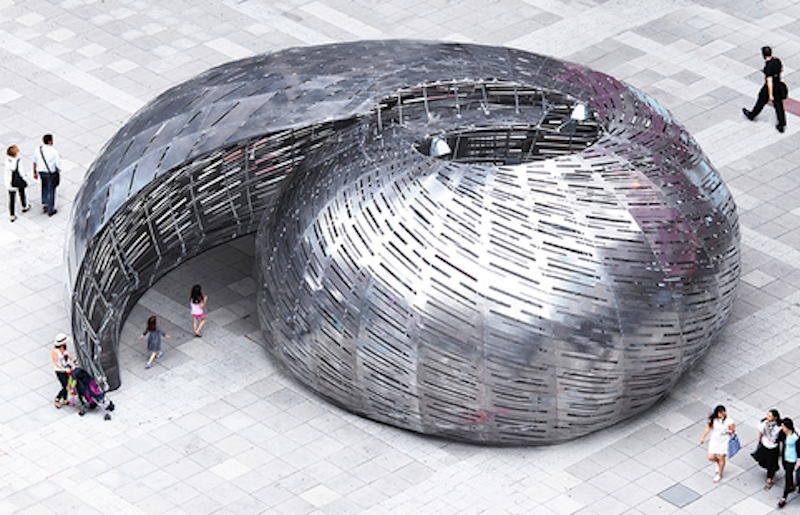NASA Orbit Pavilion, a new structure designed by StudioKCA in collaboration with the NASA Jet Propulsion Laboratory and sound artist Shane Myrbeck, looks to give visitors the experience of being surrounded by the sounds of satellites in space when it opens on Oct. 29 at The Huntington Library.
The idea behind the design of the structure was to mimic the experience of holding a seashell to one’s ear and hearing the ocean, but to do so on a much larger scale. Visitors won’t just hold this giant cosmic shell to their ears, they will walk inside of it and be met with “a symphony built out of the sounds of satellites in space,” according to Jason Kilmoski, Principal of StudioKCA.
Consisting of 28 speakers spatially arranged to mimic orbits, the pavilion acts as a sound chamber as satellites, represented by distinct, artistically created sounds, seem to swirl around visitors from above, below, and to all sides. There are 20 unique sounds in total, representing the International Space Station and 19 earth satellites.
The physical design of the structure also reflects the paths of space satellites. 100 orbital paths are cut via water jet into the 3,500 sf of aluminum panels that cover the aluminum framework of the pavilion. The design also minimizes external noise and decreases wind loads to make the experience for those within as immersive as possible.
The NASA Orbit Pavilion debuted in the summer of 2015 at the World Science Festival at New York University and will be on display at The Huntington Library until Feb. 27, 2017.
Click here to listen to the “symphony” of satellites.
Related Stories
| Jun 10, 2014
Gaudi’s famed cathedral on ice: Dutch students to construct 132-foot ice replica of Sagrada Familia
"Sagrada Familia in Ice" will be built with a mixture of wooden fibers and plain ice that is three times stronger than ice.
| Jun 10, 2014
Built-in balcony: New skylight windows can fold out to create a patio
Roof window manufacturer Fakro offers a skylight window system that quickly converts into an open-air balcony.
| Jun 10, 2014
New York's first-ever public housing for visually-impaired begins upgrade
Selis Manor is the first government-funded residence for the vision-impaired and disabled in New York City. MAP’s design eases crowding, increases security, and separates residents and visitors.
| Jun 9, 2014
6 design strategies for integrating living and learning on campus
Higher education is rapidly evolving. As we use planning and design to help our clients navigate major shifts in culture, technology, and funding, it is essential to focus on strategies that help foster an education that is relevant after graduation. One way to promote relevance is to strengthen the bond between academic disciplines and the campus residential life experience.
| Jun 9, 2014
Green Building Initiative launches Green Globes for Sustainable Interiors program
The new program focuses exclusively on the sustainable design and construction of interior spaces in nonresidential buildings and can be pursued by both building owners and individual lessees of commercial spaces.
| Jun 9, 2014
10 projects named 2014 AIA Small Project Award winners
Yale's funky new Ground café and a pavilion made from 53,780 recycled plastic bottles are among the nation's best new small projects.
| Jun 9, 2014
Eli Broad museum files $19.8 million lawsuit over delays
The museum, meant to hold Eli and Edythe Borad's collection of contemporary art, is suing the German company Seele for what the museum describes as delays in the creation of building blocks for its façade.
| Jun 8, 2014
What’s the word of the day? It’s all about ‘resiliency’
Just for the sake of argument, let’s put aside the rhetoric about climate change—whether it’s actually happening, whether it’s a result of manmade activity—and agree that we are experiencing some pretty dramatic weather events that are having huge impacts on populations here in the U.S. and worldwide.
Smart Buildings | Jun 8, 2014
Big Data: How one city took control of its facility assets with data
Over the past few years, Buffalo has developed a cutting-edge facility management program to ensure it's utilizing its facilities and operations as efficiently, effectively, and sustainably as possible.
| Jun 6, 2014
Must see: Can a floating city offset urban population growth in China?
AT Design Office has proposed a design for a floating city to offset increasing urban populations in China. To create the new city, a 10-square kilometer island would be made out of prefab blocks.
















